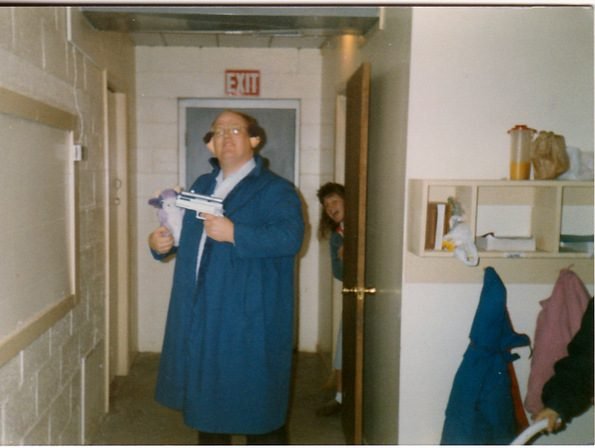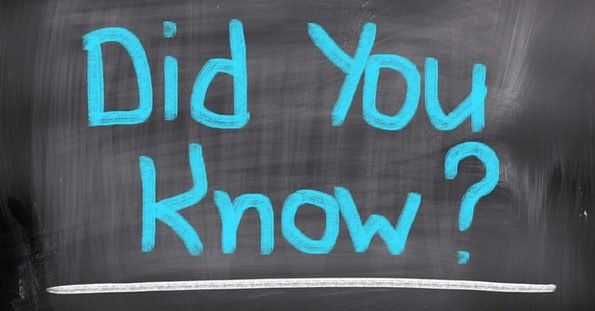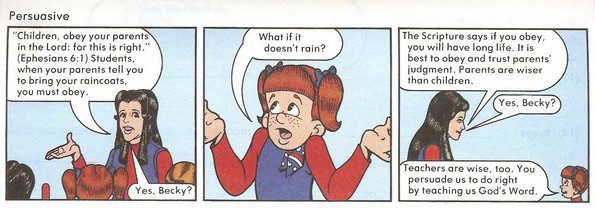
In August 1989, Somerset Baptist Academy (SBA) — a ministry of Somerset Baptist Church, Mt. Perry, Ohio — opened its doors to fifteen students. SBA was a tuition-free kindergarten-through-grade-twelve, non-chartered private school. SBA did not accept students from outside the church. Parents were required to:
- Pay an annual book fee
- Agree with SBA’s policies and code of conduct
- Agree with SBA’s use of corporal punishment
- Regularly attend church
- Regularly tithe and give offerings
The day-to-day operation of SBA fell to me as the pastor of Somerset Baptist Church. My wife, Polly, taught the younger children, along with teaching the older students English, spelling, and writing. Several church members helped teach subjects such as history and shop. I taught math, science, history, computer, and Bible classes for older students. Physical education consisted of playing games outside and taking hikes. Former students have fond memories of playing kickball in the church’s gravel parking lot.
Our 12’x60′ mobile home was parked fifty feet away from the school/church. A dear older woman in our church cared for our younger children while Polly and I taught our respective classes. Polly was eight months pregnant when SBA opened its doors. She would give birth to our first daughter in September 1989, our second daughter in 1991, and our fourth son in 1993. That’s right, Polly had three babies during the five years SBA was open. Both of us got up early, stayed up late, and spent years “living” on 5-6 hours of sleep a night. Add my pastoral duties to the mix, and Polly and I worked non-stop seven days a week. We worked this way because we sincerely believed God wanted us to train the church’s children in the ways of God. It was our duty to prepare the next generation for service.
SBA was a one-room school. All the students met in a large basement room. The room was outfitted with desks given to us by the local school district, a teacher’s desk, and a large chalkboard. In another room, students had cubbyholes to keep their books and hooks on which to hang their coats. There was no kitchen to speak of, so students were expected to pack their lunches. In the winter, the building was heated with wood and coal. Older students were expected to help stoke the wood stove and, if necessary split wood. The highlight of the one school year was when the well-casing wood stove vent pipe plugged up and filled the building with dense smoke. It took us two days to clean the building and make it ready for the students to return. (For you not familiar with well casing, it is the steel pipe used in drilling oil/gas wells. There were a lot of such wells in the area, so one member found a long section of pipe and adapted it for use with the school’s wood stove.)
Of the fifteen students, only three had previously attended a Christian school — my two oldest sons and one church girl. The other twelve had been public school students. All of the students came from poor working-class families. (The highest paid man in the church made $21,000 a year as a certified GM auto mechanic. None of the women, save one, worked outside of the home.) Many of them had previously not done well in school. Using a one room school approach allowed us to teach students at their academic levels, and not their age/grade levels. For example, I taught math. All of the students were required to take timed mathematics facts tests. Students hated these tests, but they knew the only way out of them was to pass them in the time allowed. There were several high school students who had third-grade math proficiency. They had a hard time with these tests. I didn’t cut these students any slack, expecting them to master the addition, subtraction, multiplication, and division tables.
To this day, I believe that our one-room school approach helped students who were struggling in various academic areas. This approach allowed us to give them one-on-one attention. I determined at the start that SBA would focus on the basics: reading, writing, spelling, English, and arithmetic. My belief, then, and today: teach a child to read and he or she can master anything. According to what former students have told us, we succeeded on this front. Polly, in particular, was mentioned as the one person who helped them the most when it came to reading. She was, and remains, a gem!
The first school year, I decided we would go old-school and use McGufffey Readers for grades 1-6. Dumb idea. Students struggled with the arcane language and illustrations. Older students used Mennonite textbooks published by Rod & Staff. For several classes, SBA used self-directed study programs (PACES). After the first year, we did away with the McGuffey Readers and started using Rod & Staff materials throughout the school. I taught the older students an introduction to computers. This was a hands-on class. In this regard, we were ahead of what local public school students were taught about computers.
Annually, students took the Iowa or Stanford achievement tests. I believed the tests would provide evidence for student progress. Year to year, every student improved, so whatever SBA’s shortcomings were, students were getting a good education. Good, with respect to the things we taught them. Students received a narrow, religiously-defined education, so there were holes in their educations when compared to public school programs. This was especially true when it came to higher math and science.
Religion, of course, was central to the life of SBA. Students were required to memorize passages from the King James Bible, The Westminster Confession of Faith, and the 1689 London Baptist Confession of Faith. School days were opened with prayer, though readers might be surprised to learn that students did not recite the Pledge of Allegiance. I was opposed to such recitations because I believed our allegiance belonged to God alone, and not the State. While a large U.S. flag hung on the wall in back of the church’s platform, a pledge to that flag was never uttered in the eleven years I was pastor.
As a non-chartered private religious school, SBA was exempt from state regulation. Local schools were required to give us the records of students enrolled at SBA. Outside of this, SBA had no contact with state or local officials. SBA did, however, run into a problem with the EPA. One day, an EPA investigator showed up and told me that since there was a school operating at the church, its water supply would be designated as a public water supply. We had to drill a new well ($2,000, paid by Polly’s parents), and submit water test reports every three months. One time, I thought the testing bottle had some contamination, so I washed it out with rubbing alcohol. Guess what happened next? Yeah, stupid move, Bruce. After submitting our next sample, the EPA notified us that we had a contaminant in our water supply. I explained what happened — silly, stupid me — but the EPA still required us to publish a notice in the local newspaper saying that our water system had failed its latest test and the steps we were taking to remedy that problem.
In my next post, I want to talk about how we handled discipline and what became of the children educated at Somerset Baptist Academy.
Bruce Gerencser, 68, lives in rural Northwest Ohio with his wife of 47 years. He and his wife have six grown children and sixteen grandchildren. Bruce pastored Evangelical churches for twenty-five years in Ohio, Texas, and Michigan. Bruce left the ministry in 2005, and in 2008 he left Christianity. Bruce is now a humanist and an atheist.
Your comments are welcome and appreciated. All first-time comments are moderated. Please read the commenting rules before commenting.
You can email Bruce via the Contact Form.


